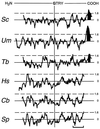Human and Saccharomyces cerevisiae dolichol phosphate mannose synthases represent two classes of the enzyme, but both function in Schizosaccharomyces pombe
- PMID: 9223280
- PMCID: PMC21522
- DOI: 10.1073/pnas.94.15.7873
Human and Saccharomyces cerevisiae dolichol phosphate mannose synthases represent two classes of the enzyme, but both function in Schizosaccharomyces pombe
Abstract
Dolichol phosphate mannose (Dol-P-Man), formed upon transfer of Man from GDPMan to Dol-P, is a mannosyl donor in pathways leading to N-glycosylation, glycosyl phosphatidylinositol membrane anchoring, and O-mannosylation of protein. Dol-P-Man synthase is an essential protein in Saccharomyces cerevisiae. We have cloned cDNAs encoding human and Schizosaccharomyces pombe proteins that resemble S. cerevisiae Dol-P-Man synthase. Disruption of the gene for the S. pombe Dol-P-Man synthase homolog, dpm1(+), is lethal. The known Dol-P-Man synthase sequences can be divided into two classes. One contains the S. cerevisiae, Ustilago maydis, and Trypanosoma brucei enzymes, which have a COOH-terminal hydrophobic domain, and the other contains the human, S. pombe, and Caenorhabditis synthases, which lack a hydrophobic COOH-terminal domain. The two classes of synthase are functionally equivalent, because S. cerevisiae DPM1 and its human counterpart both complement the lethal null mutation in S. pombe dpm1(+). The findings that Dol-P-Man synthase is essential in yeast and that the Ustilago and Trypanosoma synthases are in a different class from the human enzyme raise the possibility that Dol-P-Man synthase could be exploited as a target for inhibitors of pathogenic eukaryotic microbes.
Figures



Similar articles
-
Dolichol phosphate mannose synthase from the filamentous fungus Trichoderma reesei belongs to the human and Schizosaccharomyces pombe class of the enzyme.Glycobiology. 2000 Oct;10(10):983-91. doi: 10.1093/glycob/10.10.983. Glycobiology. 2000. PMID: 11030744
-
Cloning and sequencing of the yeast gene for dolichol phosphate mannose synthase, an essential protein.J Biol Chem. 1988 Nov 25;263(33):17499-507. J Biol Chem. 1988. PMID: 3053713
-
The isolation of a Dol-P-Man synthase from Ustilago maydis that functions in Saccharomyces cerevisiae.Yeast. 1996 Jun 30;12(8):765-71. doi: 10.1002/(SICI)1097-0061(19960630)12:8%3C765::AID-YEA974%3E3.0.CO;2-A. Yeast. 1996. PMID: 8813763
-
Enzymes that recognize dolichols participate in three glycosylation pathways and are required for protein secretion.Biochem Cell Biol. 1992 Jun;70(6):438-47. doi: 10.1139/o92-067. Biochem Cell Biol. 1992. PMID: 1333231 Review.
-
Protein O-mannosylation: what we have learned from baker's yeast.Biochim Biophys Acta. 2013 Nov;1833(11):2438-46. doi: 10.1016/j.bbamcr.2013.02.008. Epub 2013 Feb 20. Biochim Biophys Acta. 2013. PMID: 23434682 Review.
Cited by
-
Poly-Saturated Dolichols from Filamentous Fungi Modulate Activity of Dolichol-Dependent Glycosyltransferase and Physical Properties of Membranes.Int J Mol Sci. 2019 Jun 21;20(12):3043. doi: 10.3390/ijms20123043. Int J Mol Sci. 2019. PMID: 31234450 Free PMC article.
-
Rapid identification of sequences for orphan enzymes to power accurate protein annotation.PLoS One. 2013 Dec 30;8(12):e84508. doi: 10.1371/journal.pone.0084508. eCollection 2013. PLoS One. 2013. PMID: 24386392 Free PMC article.
-
Overexpression of the Saccharomyces cerevisiae mannosylphosphodolichol synthase-encoding gene in Trichoderma reesei results in an increased level of protein secretion and abnormal cell ultrastructure.Appl Environ Microbiol. 1999 Jun;65(6):2382-7. doi: 10.1128/AEM.65.6.2382-2387.1999. Appl Environ Microbiol. 1999. PMID: 10347017 Free PMC article.
-
Quantitative proteomics reveal proteins enriched in tubular endoplasmic reticulum of Saccharomyces cerevisiae.Elife. 2017 Mar 13;6:e23816. doi: 10.7554/eLife.23816. Elife. 2017. PMID: 28287394 Free PMC article.
-
Genes for glycosylphosphatidylinositol toxin biosynthesis in Plasmodium falciparum.Infect Immun. 2002 Aug;70(8):4510-22. doi: 10.1128/IAI.70.8.4510-4522.2002. Infect Immun. 2002. PMID: 12117963 Free PMC article.
References
-
- Kornfeld R, Kornfeld S. Annu Rev Biochem. 1985;54:631–664. - PubMed
-
- Tanner W, Lehle L. Biochim Biophys Acta. 1987;906:81–99. - PubMed
-
- Herscovics A, Orlean P. FASEB J. 1993;7:540–550. - PubMed
-
- Clarke B L, Naylor C, Lennarz W J. Chem Phys Lipids. 1989;51:239–247. - PubMed
-
- Abeijon C, Hirschberg C B. Trends Biochem Sci. 1992;17:32–36. - PubMed
Publication types
MeSH terms
Substances
Associated data
- Actions
- Actions
- Actions
Grants and funding
LinkOut - more resources
Full Text Sources
Other Literature Sources
Molecular Biology Databases

